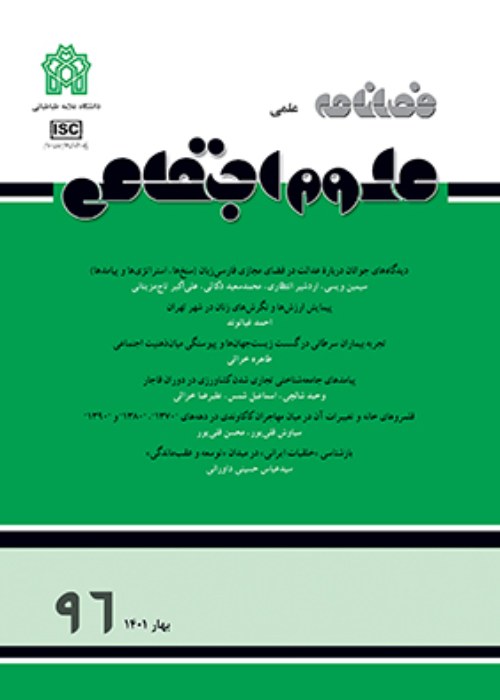Values and Lifestyles of Iranian Youth in the Last 50 Years: Continuities and Disruptions
Structural, value, historical and global transformations in the last 50 years in Iran have provided youths with new meanings and experiences and have posed them as an important player for understanding socio economic and political dynamics of Iranian society. Relying on large scale representative surveys conducted in the last decades and also drawing on some historical documents, the present paper aims to present an analysis of changes in contemporary values and lifestyles of Iranian youth and to draw the trends it has gone through. Policies, strategies and important currents like adopting western styles of development, social differentiation, discursive and ideological conflicts, imposed war, globalization, expansion of new information and communication technologies are amongst major backgrounds transforming the status of youth in Iran. While suggesting the impacts of global youth culture, the above changes are also entangled with and influenced by historical and local conditions. In sum, an assessment of historical value transformations simultaneously manifests elements of change and continuity.
Historical, structural and global transformations in the last 50 years in Iran have provided youths with new meanings and experiences and have posed them as important players in understanding socio economic and political dynamics of Iranian society. The current paper aims to draw a concise picture of youth culture transformations in the last half century in Iran and to explain the major trends according to a comparative analysis some national survey data on selective dimensions of values and lifestyles (reference points, national and religious identifications, leisure styles and participation values).
The conceptual framework draws on major trends and transformations that have been occurring during 1340 and 1350 {1960-1970}. This period is a time when modern and powerful youth emerges in Iran. The relative establishment of political governance, expansion of commercial ties with the west, an increase in oil revenues, increasing migrations from rural to urban areas, formation of new institutions offering cultural and welfare services to the youth, the expansion of popular culture infrastructures (shopping centers, sport centers, cinemas, parks and recreational centers, public libraries and so on), are amongst the major developments that together boosted youths positions and enabled them to get more involved in the socio-cultural currents of the society.
A systematic review of the both research literature dealing with youths’ values and lifestyles and youth periodicals in 1340 and 1350 along with an analysis of some national surveys conducted in the last four decades have been undertaken. The surveys both relate to those specifically designed for measuring youth attitudes and values (mostly by Iranian National Youth Organization/ Sport Ministry) and those designed for all adult age groups. In the case of the latter, care has been taken to take a sub samples as close to the youth samples as possible (those aged 15 to 29).
The findings rely on the trends of changes in the values and lifestyles of youth on themes and items like family and generational relationships, national-religious values, leisure values and participative values. On generational values, surveys suggest that generational contracts amongst age groups continues to be strong. These is no indication of severe tensions among generations and the relationships amongst youth and their parents instead tends toward mutual understanding and cooperation. The picture, however, is totally different when it comes to the judgements generations make of formal institutions and political officials.
On religious and national values, the comparison of data suggests that national and religious identity categories are rather exclusively defined by youth. In general, despite the relevance of religious values, the ritual dimensions of religion are less important for youth. Similarly, a growth in nationalistic and cosmopolitan values can vividly be observed from the recent surveys.
On leisure styles and values, trends suggest a rapid expansion in (new) media consumption from the 1380 onwards. In fact, digital leisure as the major time use of Iranian youth allow them to complement and compensate for some shortages or constraints they face in real life (particularly for some under privileged groups). On the other hand, social networks have rapidly changed Iranian youths’ leisure tastes, needs and emotional experiences. In spite of some opportunities obtained, excessive reliance on the network tends to deter youth from seeking entertainments requiring more skills and creativity.
And finally on participative values, the trends amongst Iranian youth are much similar to the global trends. A decline in political trust, a sense of unpredictability towards future and a sense of exclusion negatively affect youths’ tendencies to engage into more participation.
Structural, value, historical and global transformations in the last 50 years have turned youth from a marginal and problematic category into a strategic, sensitive and crucial phenomenon in Iran. While suggesting the impacts of global youth cultures, the above changes are also entangled with and influenced by historical and local conditions. Diversities in choices, opportunities, interpretations and representations have provided youth with exceptional opportunities for crossing youth cultural boundaries and choosing personal styles. Fluidity and diversity in the choices and fields of action have potentially created diverse venues of practicing youth. However, cultural values in Iranian society continue to be dominated by structural forces and conditions.
- حق عضویت دریافتی صرف حمایت از نشریات عضو و نگهداری، تکمیل و توسعه مگیران میشود.
- پرداخت حق اشتراک و دانلود مقالات اجازه بازنشر آن در سایر رسانههای چاپی و دیجیتال را به کاربر نمیدهد.


